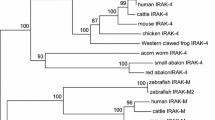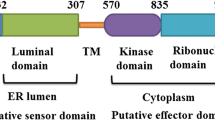Abstract
Bactericidal/permeability-increasing protein and lipopolysaccharide-binding protein (BPI/LBP) are important components of the mammalian innate defense system against Gram-negative bacterial infections. Ayu Plecoglossus altivelis altivelis BPI/LBP cDNA and its gene were cloned. The open reading frame of ayu BPI/LBP encoded a protein of 471 amino acids that contains a signal peptide and the BPI/LBP/ cholesteryl ester transfer protein-specific sequence motifs, BPI1 and BPI2. The basic amino acid residues in the LPS-binding domains of human Homo sapiens BPI and LBP and bony fishes BPI/LBP were well conserved in ayu BPI/LBP. The ayu BPI/LBP gene is composed of 15 exons and 14 introns. Ayu BPI/LBP mRNA was predominantly expressed in gill, intestine, kidney, spleen, and skin. At 4 and 7 days after the immersion challenge of Flavobacterium psychrophilum, the ayu BPI/LBP mRNA expression in the whole blood increased about fivefold in comparison with control (no challenge). Because ayu BPI/LBP mRNA increased before ayu began to die following exposure to F. psychrophilum, ayu BPI/LBP gene transcripts might be useful as a marker of the response to infectious Gram-negative bacteria or as a health status indicator.






Similar content being viewed by others
References
Hoffman JA, Kafatos FC, Janeway CA, Ezekowitz RAB (1999) Phylogenetic perspectives in innate immunity. Science 284:1313–1318
Magnadóttir B (2006) Innate immunity of fish. Fish Shellfish Immunol 20:137–151
Akira S, Takeda K, Kaisho T (2001) Toll-like receptors: critical proteins linking innate and acquired immunity. Nat Immunol 2:75–80
Mushegian A, Medzhitov R (2001) Evolutionary perspective on innate immune recognition. J Cell Biol 155:705–710
Alexander C, Rietschel ET (2001) Bacterial lipopolysaccharides and innate immunity. J Endotoxin Res 7:167–202
Weiss J (2003) Bactericidal/permeability-increasing protein (BPI) and lipopolysaccharide-binding protein (LBP): structure, function and regulation in host defence against Gram-negative bacteria. Biochem Soc Trans 31:785–790
Bingle CD, Craven CJ (2004) Meet the relatives: a family of BPI- LBP-related proteins. Trends Immunol 25:53–55
Gray PW, Corcorran AE, Eddy RLJ, Byers MG, Shows TB (1993) The genes for the lipopolysaccharide binding protein (LBP) and the bactericidal permeability increasing protein (BPI) are encoded in the same region of human chromosome 20. Genomics 15:188–190
Hubacek JA, Buchler C, Aslanidis C, Schmitz G (1997) The genomic organization of the genes for human lipopolysaccharide binding protein (LBP) and bactericidal permeability increasing protein (BPI) is highly conserved. Biochem Biophys Res Commun 236:427–430
Schumann RR, Leong SR, Flaggs GW, Gray PW, Wright SD, Mathison JC, Tobias PS, Ulevitch RJ (1990) Structure and function of lipopolysaccharide binding protein. Science 249:1429–1431
Iovine NM, Elsbach P, Weiss J (1997) An opsonic function of the neutrophil bactericidal/permeability-increasing protein depends on both its N- and C-terminal domains. Proc Natl Acad Sci USA 94:10973–10978
Beamer LJ, Carroll SF, Eisenberg D (1998) The BPI/LBP family of proteins: a structural analysis of conserved regions. Protein Sci 7:906–914
Tobias PS, Mathison JC, Ulevitch RJ (1988) A family of lipopolysaccharide binding proteins involved in responses to gram-negative sepsis. J Biol Chem 263:13479–13481
Tobias PS, Soldau K, Iovine NM, Elsbach P, Weiss J (1997) Lipopolysaccharide (LPS)-binding proteins BPI and LBP form different types of complexes with LPS. J Biol Chem 272:18682–18685
Weiss J, Franson RC, Beckerdite S, Schmeidler K, Elsbach P (1975) Partial characterization and purification of a rabbit granulocyte factor that increases permeability of Escherichia coli. J Clin Invest 55:33–42
Weiss J, Elsbach P, Olsson I, Odeberg H (1978) Purification and characterization of a potent bactericidal and membrane active protein from the granules of human polymorphonuclear leukocytes. J Biol Chem 253:2664–2672
Mannion BA, Weiss J, Elsbach P (1990) Separation of sublethal and lethal effects of the bactericidal/permeability increasing protein on Escherichia coli. J Clin Invest 85:853–860
Tobias PS, Soldau K, Ulevitch RJ (1986) Isolation of a lipopolysaccharide-binding acute phase reactant from rabbit serum. J Exp Med 164:777–793
Wright SD, Ramos RA, Tobias PS, Ulevitch RJ, Mathison JC (1990) CD14, a receptor for complexes of lipopolysaccharide (LPS) and LPS binding protein. Science 249:1431–1433
Chow JC, Young DW, Golenbock DT, Christ WJ, Gusovsky F (1999) Toll-like receptor-4 mediates lipopolysaccharide-induced signal transduction. J Biol Chem 274:10689–10692
Nagai Y, Akashi S, Nagafuku M, Ogata M, Iwakura Y, Akira S, Kitamura T, Kosugi A, Kimoto M, Miyake K (2002) Essential role of MD-2 in LPS responsiveness and TLR4 distribution. Nat Immunol 3:667–672
Gray PW, Flaggs G, Leong SR, Gumina RJ, Weiss J, Ooi CE, Elsbach P (1989) Cloning of the cDNA of a human neutrophil bactericidal protein. Structural and functional correlations. J Biol Chem 264:9505–9509
Leong SR, Camerato T (1990) Nucleotide sequence of the bovine bactericidal permeability increasing protein (BPI). Nucleic Acids Res 18:3052
Zarember K, Elsbach P, Shin-Kim K, Weiss J (1997) p15 s (15-kD antimicrobial proteins) are stored in the secondary granules of rabbit granulocytes: implications for antibacterial synergy with the bactericidal/permeability-increasing protein in inflammatory fluids. Blood 89:672–679
Gallay P, Carrel S, Glauser MP, Barras C, Ulevitch RJ, Tobias PS, Baumgartner JD, Heumann D (1993) Purification and characterization of murine lipopolysaccharide-binding protein. Infect Immun 61:378–383
Lengacher S, Jongeneel CV, Le Roy D, Lee JD, Kravchenko V, Ulevitch RJ, Glauser MP, Heumann D (1995) Reactivity of murine and human recombinant LPS-binding protein (LBP) within LPS and gram negative bacteria. J Inflamm 47:165–172
Su GL, Freeswick PD, Geller DA, Wang Q, Shapiro RA, Wan YH, Billiar TR, Tweardy DJ, Simmons RL, Wang SC (1994) Molecular cloning, characterization, and tissue distribution of rat lipopolysaccharide binding protein. Evidence for extrahepatic expression. J Immunol 153:743–752
Inagawa H, Honda T, Kohchi C, Nishizawa T, Yoshiura Y, Nakanishi T, Yokomizo Y, Soma G (2002) Cloning and characterization of the homolog of mammalian lipopolysaccharide-binding protein and bactericidal permeability-increasing protein in rainbow trout Oncorhynchus mykiss. J Immunol 168:5638–5644
Kono T, Sakai M (2003) Molecular cloning of a novel bactericidal permeability-increasing protein/lipopolysaccharide-binding protein (BPI/LBP) from common carp Cyprinus carpio L. and its expression. Mol Immunol 40:269–278
Stenvik J, Solstad T, Strand C, Leiros I, Jorgensen T (2004) Cloning and analyses of a BPI/LBP cDNA of the Atlantic cod (Gadus morhua L.). Dev Comp Immunol 28:307–323
Xu P, Bao B, He Q, Peatman E, He C, Liu Z (2005) Characterization and expression analysis of bactericidal permeability-increasing protein (BPI) antimicrobial peptide gene from channel catfish Ictalurus punctatus. Dev Comp Immunol 29:865–878
Huang Y, Lou H, Wu X, Chen Y (2008) Characterization of the BPI-like gene from a subtracted cDNA library of large yellow croaker (Pseudosciaena crocea) and induced expression by formalin-inactivated Vibrio alginolyticus and Nocardia seriolae vaccine challenges. Fish Shellfish Immunol 25:740–750
Sako H, Kusuda R (1978) Chemotherapeutic studies on trimethoprim against vibriosis of pond-cultured Ayu-I. Microbiological evaluation of trimethoprim and sulfonamides on the causative agent Vibrio anguillarum (in Japanese with English abstract). Fish Pathol 13:91–96
Muroga K, Egusa S (1988) Vibriosis of ayu: a review. J Fac Appl Biol Sci Hiroshima Univ 27:1–17
Wakabayashi H, Toyama T, Iida T (1994) A study on serotyping of Cytophaga psychrophila isolated from fishes in Japan. Fish Pathol 29:101–104
Iida Y, Mizokami A (1996) Outbreaks of coldwater disease in wild ayu and pale chub. Fish Pathol 31:157–164
Wakabayashi H, Sawada K, Ninomiya K, Nishimori E (1996) Bacterial hemorrhagic ascites of ayu caused by Pseudomonas sp. (in Japanese with English abstract). Fish Pathol 31:239–240
Nishimori E, Kita-Tsukamoto K, Wakabayashi H (2000) Pseudomonas plecoglossicida sp. nov., the causative agent of bacterial haemorrhagic ascites of ayu, Plecoglossus altivelis. Int J Syst Evol Microbiol 50:83–89
Plouffe DA, Hanington PC, Walsh JG, Wilson EC, Belosevic M (2005) Comparison of select innate immune mechanisms of fish and mammals. Xenotransplantation 12:266–277
Whyte SK (2007) The innate immune response of finfish—a review of current knowledge. Fish Shellfish Immunol 23:1127–1151
Altschul SF, Gish W, Miller W, Myers EW, Lipman EW (1990) Basic local alignment search tool. J Mol Biol 215:403–410
Higgins D, Thompson J, Gibson T, Thompson JD, Higgins DG, Gibson TJ (1994) CLUSTAL W: improving the sensitivity of progressive multiple sequence alignment through sequence weighting, position-specific gap penalties and weight matrix choice. Nucleic Acids Res 22:4673–4680
Schultz J, Milpetz F, Bork P, Ponting CP (1998) SMART, a simple modular architecture research tool: identification of signaling domains. Proc Natl Acad Sci USA 95:5857–5864
Letunic I, Copley RR, Pils B, Pinkert S, Schultz J, Bork P (2006) SMART 5: domains in the context of genomes and networks. Nucleic Acids Res 34:D257–D260
Emanuelsson O, Brunak S, von Heijne G, Nielsen H (2007) Locating proteins in the cell using TargetP, SignalP and related tools. Nat Protoc 2:953–971
Saitou N, Nei M (1987) The neighbour-joining method: a new method for reconstructing phylogenetic trees. Mol Biol Evol 4:406–425
Felsenstein J (1985) Confidence limits on phylogenies: an approach using the bootstrap. Evolution 39:783–791
Tamura K, Dudley J, Nei M, Kumar S (2007) MEGA4: molecular evolutionary genetics analysis (MEGA) software version 4.0. Mol Biol Evol 24:1596–1599
Beamer LJ, Carroll SF, Eisenberg D (1999) The three-dimensional structure of human bactericidal/permeability-increasing protein: implications for understanding protein-lipopolysaccharide interactions. Biochem Pharmacol 57:225–229
Iliev DB, Roach JC, Mackenzie S, Planas JV, Goetz FW (2005) Endotoxin recognition: in fish or not in fish? FEBS Lett 579:6519–6528
Bird S, Zou J, Savan R, Kono T, Sakai M, Woo J, Secombes C (2005) Characterisation and expression analysis of an interleukin-6 homologue in the Japanese pufferfish, Fugu rubripes. Dev Comp Immunol 29:775–789
Nam BH, Byon JY, Kim YO, Park EM, Cho YC, Cheong JH (2007) Molecular cloning and characterisation of the flounder (Paralichthys olivaceus) interleukin-6 gene. Fish Shellfish Immunol 23:231–236
Solstad T, Stenvik J, Jorgensen T (2007) mRNA expression patterns of the BPI/LBP molecule in the Atlantic cod (Gadus morhua L.). Fish Shellfish Immunol 23:260–271
Author information
Authors and Affiliations
Corresponding author
Rights and permissions
About this article
Cite this article
Suzuki, K., Izumi, S., Tanaka, H. et al. Molecular cloning and expression analysis of the BPI/LBP cDNA and its gene from ayu Plecoglossus altivelis altivelis . Fish Sci 75, 673–681 (2009). https://doi.org/10.1007/s12562-009-0072-6
Received:
Accepted:
Published:
Issue Date:
DOI: https://doi.org/10.1007/s12562-009-0072-6




